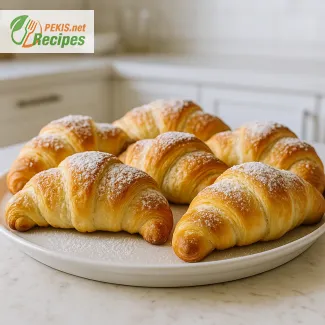
Christmas Bread with Dried Fruit and Nuts is a treasured holiday treat that brings warmth, richness, and festive cheer to the table. A deeply flavorful bread, it combines dried fruits, nuts, and spices to capture the essence of the season in every bite. Its fragrant aroma fills the kitchen, evoking memories of cozy winter gatherings and joyful family traditions. Perfectly golden on the outside and soft and dense on the inside, this bread is a delightful way to celebrate Christmas mornings or festive evenings with loved ones.
Made with a rich dough, Christmas bread is often subtly sweetened, with notes of honey or brown sugar that enhance its heartwarming flavors. The dough itself is enriched with butter, which gives it a soft, almost cake-like crumb, making each slice satisfyingly tender. But it’s the combination of dried fruits and nuts that truly sets this bread apart. Raisins, dried apricots, figs, cranberries, or even a mix of exotic fruits are often soaked in rum or orange juice beforehand to infuse a deeper taste, creating a sweet and tangy contrast that complements the dough’s richness. Meanwhile, crunchy nuts such as walnuts, almonds, or pecans add texture and a slightly nutty flavor, balancing the bread's sweetness with earthy undertones.
In many recipes, Christmas bread is spiced with a hint of cinnamon, nutmeg, cloves, or cardamom, infusing each slice with the aromas synonymous with winter and holiday cheer. The spices, combined with citrus zest—often from oranges or lemons—add brightness and complexity, elevating the bread into a celebration of flavors. The result is a bread that’s not only delicious but also a feast for the senses, with its inviting smell, colorful specks of fruit, and satisfying texture.
Enjoying a slice of this bread is a festive ritual in itself. It’s versatile enough to be paired with butter, honey, or even a thick spread of cream cheese, creating a comforting and decadent experience. Some versions are also glazed or topped with a sprinkle of powdered sugar, adding a final touch of sweetness and a visually pleasing snow-dusted effect. Christmas bread is more than just a seasonal treat; it’s a labor of love that brings family and friends together around the table, encouraging a moment to savor the holiday spirit.
This bread is often prepared a day or two in advance to allow the flavors to develop, and it keeps well, making it an excellent option for holiday gatherings or as a thoughtful homemade gift. Wrapped in decorative paper and tied with a ribbon, a loaf of Christmas bread with dried fruit and nuts becomes a heartfelt gift that shares a bit of holiday warmth and tradition. Its long shelf life also means it’s a treat that can be enjoyed slowly, providing comfort and festive flavor over several days, and is equally delightful when toasted and served with a touch of butter for a cozy winter breakfast.
Whether you’re following a traditional recipe passed down through generations or experimenting with your own twists, Christmas bread invites creativity and personalization. With each loaf, you’re part of a time-honored tradition, connecting with the spirit of giving and joy that defines the season. It’s a bread that invites you to pause, share, and enjoy, adding a touch of magic to your holiday celebrations.
- Activate Yeast: Warm the milk (37°C) in a saucepan, then remove from heat. Add yeast and 1 tsp sugar, stirring gently. Let it sit for 5-10 minutes until it becomes foamy.
- Prepare Dough: In a large bowl, mix the flour, sugar, salt, cinnamon, and nutmeg. Make a well in the center, add the milk and yeast mixture, egg, and melted butter. Mix until a sticky dough forms.
- Add Fruits and Nuts: Fold in the dried fruit, nuts, and orange zest. Knead for 5-7 minutes until the dough is smooth and elastic. If needed, add a bit of extra flour.
- First Rise: Place the dough in a greased bowl, cover with a damp cloth, and let it rise in a warm place for about 1 hour or until doubled in size.
- Shape and Second Rise: Punch down the dough and shape it into a loaf. Place it in a greased loaf pan, cover, and let it rise for an additional 30 minutes.
- Bake: Preheat oven to 180°C (350°F). Bake the bread for 35-40 minutes or until golden brown. The bread is ready when a toothpick inserted in the center comes out clean.
- Cool and Serve: Let the bread cool for 10-15 minutes before slicing.
Creating the perfect Christmas bread with dried fruit and nuts involves balancing ingredients, flavors, and textures. Here are some professional tips and insights to help refine or personalize the recipe for different preferences, dietary needs, and unique twists. From ingredient substitutions to flavor enhancements, these suggestions will help elevate the traditional Christmas bread into a memorable holiday centerpiece.
1. Enhancing Flavor with Soaked Fruits
- Soaking Dried Fruits: Dried fruits like raisins, cranberries, apricots, or figs can be soaked in warm liquid to enhance their flavor and texture. Traditional recipes often use rum or brandy for a warm, festive aroma, but non-alcoholic options work just as well. Soak the fruit in orange juice for a citrusy note or in warm apple cider for a cozy, spiced flavor. Let the fruits soak for at least 30 minutes to plump them up, which will also help retain moisture in the bread.
- Alternative Flavors: Experiment with spiced teas (like chai or cinnamon) as a soaking liquid to introduce subtle, aromatic flavors without additional spices. This twist is especially useful if you want a more complex taste profile without using alcohol or excessive spices.
2. Texture and Crunch Adjustments
- Nuts Variety and Preparation: Using different types of nuts can significantly impact both texture and flavor. Walnuts and pecans lend a softer, buttery crunch, while almonds add a firmer, slightly sweet flavor. Lightly toasting nuts before adding them to the dough enhances their flavor and crunch. Simply spread the nuts on a baking tray and roast at 180°C (350°F) for 8-10 minutes, stirring once halfway.
- Seeds as Nut Alternatives: If you’re catering to someone with nut allergies, replace nuts with seeds like sunflower seeds, pumpkin seeds, or sesame seeds. These offer similar textures with their own unique flavors and are also rich in healthy fats and minerals.
3. Adjusting Sweetness and Sugar Types
- Sugar Alternatives: Brown sugar adds a caramel-like depth to the bread, but coconut sugar or date sugar can also be used for a slightly lower glycemic index and a naturally caramelized flavor. For a subtle sweetness, use honey or maple syrup; however, remember to reduce the milk slightly to maintain dough consistency if using liquid sweeteners.
- Reduced Sugar for Less Sweet Bread: If you prefer a less sweet bread, reduce the sugar by 25-30%. The dried fruits already add natural sweetness, so even with less sugar, the bread retains a festive flavor.
4. Adjusting the Dough for a Softer or Denser Crumb
- Softer Bread Texture: For a softer, more tender crumb, replace some of the all-purpose flour with bread flour or add 1-2 tablespoons of extra butter. Bread flour has a higher protein content, which creates more gluten, giving a softer, chewier texture.
- Dense and Hearty Bread: If you want a denser texture, substitute a portion (up to 25%) of the all-purpose flour with whole wheat flour. This enhances the bread’s nutty flavor and provides additional fiber. Note that whole wheat flour absorbs more liquid, so you may need to add an extra tablespoon of milk for optimal dough consistency.
5. Spice Adjustments for Unique Aromas
- Classic Holiday Spices: Cinnamon and nutmeg are traditional, but adding ground ginger or cloves introduces a spicy warmth. For a more complex aroma, use a small pinch of cardamom. Each spice should be used sparingly to avoid overwhelming the bread’s natural flavors.
- Citrus for Brightness: While orange zest is commonly used, a touch of lemon zest can add a fresh brightness that complements the dried fruit. Alternatively, add a teaspoon of vanilla extract for a sweet, floral note or a few drops of almond extract for a hint of warmth and depth.
6. Alternative Rising and Proofing Methods
- Cold Fermentation: For a deeper flavor, consider cold-fermenting the dough. After kneading, cover and refrigerate it overnight. This slower rise allows flavors to develop more fully, giving the bread a subtle tang and complexity. Allow the dough to come to room temperature and perform a final rise before baking.
- Quick Rise with Instant Yeast: If short on time, use instant yeast instead of active dry yeast, which allows for a faster rise. Just add instant yeast directly to the flour without activating it in milk. You may need to slightly shorten the first rise time by 15-20 minutes.
7. Presentation and Decoration Tips
- Classic Powdered Sugar Topping: A dusting of powdered sugar after baking gives a snow-dusted effect, perfect for the holiday season.
- Simple Glaze: For a festive finish, drizzle a glaze made with powdered sugar and orange juice or milk. This adds a delicate sweetness and a beautiful shine.
- Festive Garnish: Garnish with a few extra chopped nuts or whole dried fruits before baking for a rustic, artisanal look. Press them lightly into the top of the loaf to keep them in place as the bread bakes.
8. Nutritional and Dietary Adaptations
- Gluten-Free Alternative: For a gluten-free version, replace all-purpose flour with a high-quality gluten-free flour blend that includes xanthan gum. Gluten-free dough can be denser, so consider adding an extra egg white to enhance the structure.
- Vegan Adjustments: Substitute butter with vegan butter or coconut oil and the egg with a flaxseed egg (1 tbsp ground flaxseed + 3 tbsp water). Use almond milk or oat milk instead of dairy milk.
- Lowering Fat Content: For a lower-fat version, replace half the butter with Greek yogurt or unsweetened applesauce. These substitutes add moisture while reducing the fat content, making the bread slightly denser but still delicious.
9. Storage Tips to Retain Freshness
- Proper Storage: Once cooled, wrap the bread tightly in plastic wrap and store in an airtight container at room temperature for up to 3 days. For longer storage, refrigerate or freeze it. To enjoy a warm slice, reheat in a toaster or oven.
- Freezing Option: Christmas bread freezes exceptionally well. Slice the bread and wrap each slice individually in plastic wrap. Place the slices in a ziplock bag, removing excess air before sealing. When ready to serve, thaw and warm as desired.
10. Serving Suggestions and Pairings
- For Breakfast: Serve a toasted slice with a pat of butter and a sprinkle of cinnamon for a cozy holiday breakfast. It pairs wonderfully with a cup of coffee or chai tea.
- Holiday Brunch Addition: Serve with a variety of spreads like cream cheese, honey, or fruit preserves. The bread’s mild sweetness and hearty texture make it an excellent addition to a holiday brunch spread.
- Gifting Ideas: Christmas bread makes a wonderful homemade gift. Wrap in decorative paper or place in a festive bread bag with a ribbon and attach a personalized note.
Each of these tips allows you to make small but impactful changes, resulting in a Christmas bread that’s uniquely suited to your taste and dietary preferences. Whether you’re following the classic recipe or incorporating modern twists, these insights ensure that the bread will be an unforgettable centerpiece, filled with the warmth and richness of the holiday season.
- Contains gluten, dairy, and nuts.
Substitutions:
- For a gluten-free version, use gluten-free flour mix.
- Substitute dairy milk with almond or oat milk for lactose intolerance.
- Replace nuts with seeds (sunflower or pumpkin) for a nut-free version.
- Vitamin B6: Supports brain health and metabolism.
- Vitamin E (from nuts): Powerful antioxidant, promotes skin health.
- Iron: Supports red blood cell formation and energy.
- Calcium: Bone health support.
- Vitamin C (from orange zest): Strengthens immunity.
- Polyphenols (in nuts and dried fruits): Reduces inflammation.
- Flavonoids (in dried fruits): Supports heart health.





